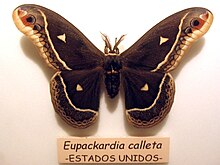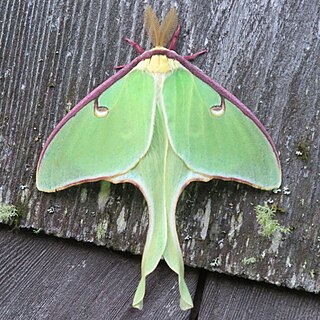
The luna moth, also called the American moon moth, is a Nearctic moth in the family Saturniidae, subfamily Saturniinae, a group commonly named the giant silk moths.
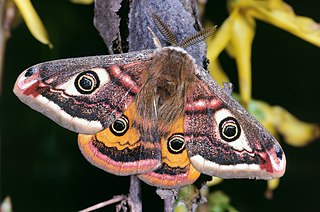
Saturniidae, members of which are commonly named the saturniids, is a family of Lepidoptera with an estimated 2,300 described species. The family contains some of the largest species of moths in the world. Notable members include the emperor moths, royal moths, and giant silk moths.

Eacles imperialis, the imperial moth, is a member of the family Saturniidae and subfamily Ceratocampinae. It is found mainly in the East of South America and North America, from the center of Argentina to south Canada. The species was first described by Dru Drury in 1773.

Hyalophora cecropia, the cecropia moth, is North America's largest native moth. It is a member of the family Saturniidae, or giant silk moths. Females have been documented with a wingspan of five to seven inches or more. These moths can be found all across North America as far west as Washington and north into the majority of Canadian provinces. Cecropia moth larvae are most commonly found on maple trees, but they have also been found on cherry and birch trees among many others. The species was first described by Carl Linnaeus in his 1758 10th edition of Systema Naturae.
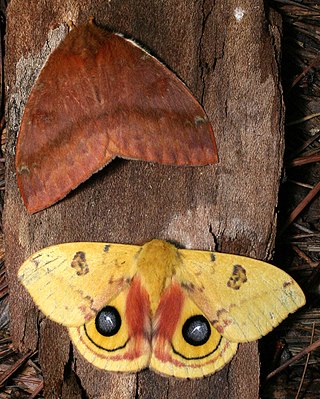
Automeris io, the Io moth or peacock moth, is a colorful North American moth in the family Saturniidae. The Io moth is also a member of the subfamily Hemileucinae. The name Io comes from Greek mythology in which Io was a mortal lover of Zeus. The Io moth ranges from the southeast corner of Manitoba and in the southern extremes of Ontario, Quebec, New Brunswick and Nova Scotia in Canada, and in the US it is found from Montana, North Dakota, South Dakota, Nebraska, Colorado, New Mexico, Texas, Utah, east of those states and down to the southern end of Florida. The species was first described by Johan Christian Fabricius in 1775.
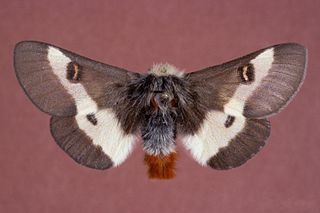
The buck moth is a common insect found in oak forests, stretching in the United States from peninsular Florida to New England, and as far west as Texas and Kansas. It was first described by Dru Drury in 1773. The larvae typically emerge in a single generation in the spring. The larvae are covered in hollow spines that are attached to a poison sac. The poison can cause symptoms ranging from stinging, itching and burning sensations to nausea. Subspecies Hemileuca maia maia is listed as endangered in the US state of Connecticut.

Cydia saltitans or jumping bean moth is a moth from Mexico that is most widely known as its larva, where it inhabits the carpels of seeds from several related shrubby trees, mainly Sebastiania pavoniana or Sapium biloculare. These seeds are commonly known as Mexican jumping beans.

Leucophyllum frutescens is an evergreen shrub in the figwort family, Scrophulariaceae, native to the U.S. state of Texas, where it is the official "State Native Shrub of Texas", and to the states of Coahuila, Nuevo León, and Tamaulipas in northern Mexico. Although commonly known as Texas sage, it is not a true sage and is distinct from the genus Salvia. The species is also called Texas Ranger, Texas rain sage, cenizo, Texas silverleaf, Texas barometerbush, ash-bush, wild lilac, purple sage, senisa, cenicilla, palo cenizo, or hierba del cenizo.

Callosamia promethea, commonly known as the promethea silkmoth, is a member of the family Saturniidae, which contains approximately 1,300 species. It is also known as the spicebush silkmoth, which refers to one of the promethea silkmoth's common host plants, spicebush. C. promethea is classified as a silk moth, which stems from its ability to produce silk, which it does in the formation of its cocoon. C. promethea lives in forests in the eastern U.S. and does not damage the trees on which it lives. The species was first described by Dru Drury in 1773.

Glyptapanteles is a genus of endoparasitoid wasps found in all continents, except Antarctica. The larvae of Glyptapanteles species are able to manipulate their hosts into serving as bodyguards.

Microgastrinae is a subfamily of braconid wasps, encompassing almost 3,000 described species, with an estimated 30,000–50,000 total species. This makes it one of the richest subfamilies with the most species of parasitoid wasps.
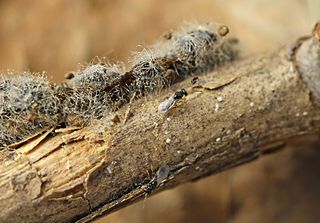
Euplectrus is a genus of hymenopteran insects of the family Eulophidae.

Arsenura armida, the giant silk moth, is a moth of the family Saturniidae. It is found mainly in South and Central America, from Mexico to Bolivia, and Ecuador to south-eastern Brazil. It was first described by Pieter Cramer in 1779.
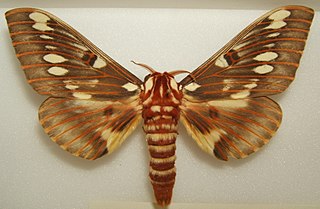
Citheronia splendens, the splendid royal moth, is a moth of the family Saturniidae. It is found from southern Arizona south into central and south-eastern Mexico. The species was first described by Herbert Druce in 1886.

Gynaephora groenlandica, the Arctic woolly bear moth, is an erebid moth native to the High Arctic in the Canadian archipelago, Greenland and Wrangel Island in Russia. It is known for its slow rate of development, as its full caterpillar life cycle may extend up to 7 years, with moulting occurring each spring. This species remains in a larval state for the vast majority of its life. Rare among Lepidoptera, it undergoes an annual period of diapause that lasts for much of the calendar year, as G. groenlandica is subject to some of the longest, most extreme winters on Earth. In this dormant state, it can withstand temperatures as low as −70 °C. The Arctic woolly bear moth also exhibits basking behavior, which aids in temperature regulation and digestion and affects both metabolism and oxygen consumption. Females generally do not fly, while males usually do.
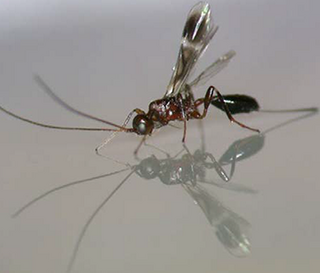
Spathius agrili is a parasitic non-stinging wasp of family Braconidae which is native to North Asia. It is a parasitoid of the emerald ash borer, an invasive species which has destroyed tens of millions of ash trees in its introduced range in North America. As part of the campaign against the emerald ash borer (EAB), American scientists in conjunction with the Chinese Academy of Forestry began searching in 2003 for its natural enemies in the wild, leading to the discovery of several parasitoid wasp species, including Spathius agrili. S. agrili was discovered in Tianjin, China where it is a prevalent parasitoid of EAB larvae in stands of an introduced ash species, and an endemic ash species. S. agrili has been recorded to attack and kill up to 90 percent of EAB larvae.
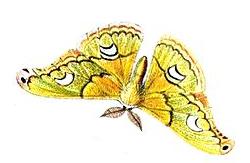
Copaxa sapatoza is a species of moth in the family Saturniidae first described by John O. Westwood in 1854 as Saturnia sapatoza. It is found in the north-east of the Andean Cordillera in Colombia at high elevations.

Rothschildia jorulla is a species of moth in the family Saturniidae first described by John O. Westwood in 1854. This species is found in Mexico and Central America. Larvae feed on plants of a large number of families.

Antheraea paphia, known as the South India small tussore, the tasar silkworm and vanya silkworm is a species of moth of the family Saturniidae found in India and Sri Lanka. The bulk of the literature on this species uses a junior synonym, Antheraea mylitta, rather than the correct name, A. paphia. It is one of a number of tasar silkworms, species that produce Tussar silk, a kind of wild silk that is made from the products of saturniid silkworms instead of the domesticated silkworm.
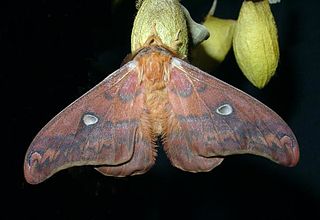
Rhodinia fugax, the squeaking silkmoth, is a moth in the family Saturniidae. It was described by Arthur Gardiner Butler in 1877. It is native to Korea, Japan, China, and the Russian Far East.
